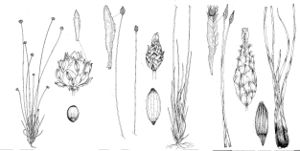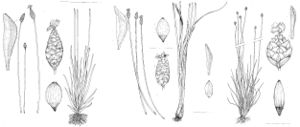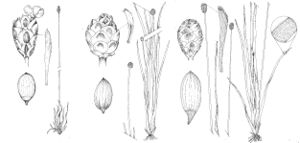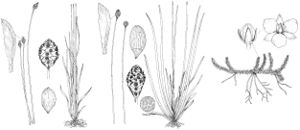Xyridaceae
Herbs, perennial or annual, mostly heliophytes of acidic wetlands, rarely aquatic. Leaves alternate, 2-ranked (occasionally many-ranked); base equitant, sheathing or open, sometimes with ligule or auricles at junction; blade mostly linear or filiform, flat to variously thickened and/or sulcate [lingulate], margins entire to papillate or scabrous; venation parallel. Inflorescences terminal; scape sheaths proximally tubular, distally open, bladed; scapes erect, linear to filiform, not bracteate [bracteate]; spikes single [cluster, rarely panicle of spikes], conelike; bracts chaffy. Flowers bisexual, radially [bilaterally] symmetric; sepals [2–] 3, unequal [equal], outer 2 (lateral sepals) nearly opposite, connivent to variously connate, clasping mature capsule, inner sepal membranous (occasionally similar to others or absent), abcissing as flower opens; petals 3, equal [unequal], distinct [connate]; stamens 3; staminodes (0–) 3, 2-brachiate, free [adnate to perianth or absent]; anthers 4-sporangiate, 2-locular at anthesis; pollen monosulcate or inaperturate; ovaries y superior, 1 [–3] -locular; ovules anatropous; styles 1, distally 3-branched [simple]; stigmas 3 [1, 3-lobed, capitate, or funnelform]. Fruits capsular, mostly loculicidal. Seeds [1–6–] 15–90 or more, mostly under 2 [–4] mm, mostly ridged or lined.
Distribution
Tropical and subtropical regions
Discussion
All North American Xyris increase by axillary buds, and thus the solitary habit is rare, often a result of poor or droughty habitat. A few can be termed annual or short-lived perennials (i.e., X. brevifolia, X. flabelliformis, X. jupicai). Of these only S. jupicai tends to die to the base at the end of a growing season.
In North American Xyris, leaf arrangement is distichous (2-ranked) and equitant (much as it is in Iris), the sheath margins converging at the junction of sheath and blade to form one edge of the leaf blade, with the midzone (or keel) of the sheath making up the other edge (a "unifacial" blade). A few species show some trends toward a spiral arrangement, typically displayed by a bulbous habit (X. caroliniana, X. platylepis, X. scabrifolia, X. tennesseensis, XS. torta). In these species, the leaf sheath is abruptly dilated at the base, imparting a swollen, bulblike aspect to the plant base.
While all All North American Xyris have unifacial leaf blades, some neotropical species do not. In those the latter the sheath margins do not completely converge when passing into the blade, and the blade may have a deep, narrow or broad groove or sulcus adaxially. A tendency toward this is shown in X. baldwiniana and X. isoetifolia.
The staminode in nearly all Xyris is much like a petal, being long-clawed at the base. The staminodial blade is typically 2-lobed, each lobe with a margin of long, moniliform hairs, each hair a chain of tiny cells connected much like a string of beads. Species-by-species taxonomic evaluations of those hairs, particularly SEM studies, have yet to be done. Of the species treated herein, only X. baldwiniana lacks bearded staminodes.
The keys and descriptions below are constructed from study of mature, preferably fruiting specimens. Bracts and sepals tend to grow substantially after flowering, and the measurements of lateral sepals are based on sepals that subtend ripe fruit.
North American Xyris have no nectaries, and the pollen reward is relatively scanty. A few bees and flies are occasional visitors. Usually pollination of these species appears to be by wind or by pollen-feeding insects.
Genera 5, species ca. 300 (1 genus, 21 species in the flora).



